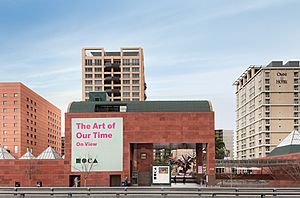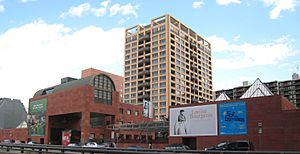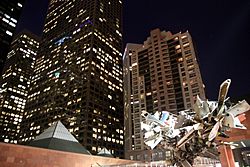Museum of Contemporary Art, Los Angeles facts for kids
 |
|

The Museum of Contemporary Art in Downtown Los Angeles
|
|
| Established | 1979 |
|---|---|
| Location | 250 South Grand Avenue Los Angeles, California 90012, U.S. |
| Type | Art museum |
| Public transit access | Pershing Square Civic Center/Grand Park Grand Avenue Arts/Bunker Hill |
The Museum of Contemporary Art, Los Angeles (often called MOCA) is an art museum in Los Angeles, California. It has two main locations in the city. The main building is on Grand Avenue in Downtown Los Angeles, close to the Walt Disney Concert Hall. MOCA's other important location is the Geffen Contemporary, found in the Little Tokyo area of downtown Los Angeles.
MOCA's art collection mainly features contemporary art from America and Europe. These artworks were created after 1940. From the very beginning, MOCA has been known for showing many different kinds of contemporary art.
Contents
How MOCA Started
The idea for MOCA began in 1979 at a special event. A local art lover named Marcia Simon Weisman talked about how Los Angeles needed a museum for contemporary art. Her brother, Norton Simon, had helped the Pasadena Art Museum in 1975, but it couldn't keep its focus on modern art.
Soon after, the Mayor's Museum Advisory Committee was formed. This group worked to create a new museum from scratch. They needed to find money, leaders, art experts, a building, and most importantly, an art collection. That same year, Marcia Weisman and five other major art collectors promised parts of their own art collections to help start the museum. These gifts were worth up to $6 million.
In 1980, the new Museum of Contemporary Art opened an office. Important people in Los Angeles who loved art joined the museum's board. They aimed to raise $10 million in their first year. Artists were also involved early on to help guide the museum. Large donations from people like Eli Broad and Max Palevsky, and companies like Atlantic Richfield Co., helped make the new museum building possible. Eli Broad became MOCA's first chairman.
MOCA's Amazing Art Collection
MOCA's permanent collection has nearly 6,000 artworks. Most of these pieces were given as gifts by major private collectors. Many board members have donated or given important artworks or even entire collections to the museum. Sometimes, they sold art to the museum at very good prices.
Soon after opening in 1983, MOCA became a big name in the art world. This happened when it bought 80 important artworks from Giuseppe Panza, one of its board members. This 1984 purchase included famous abstract expressionism and pop art pieces by artists like Franz Kline, Roy Lichtenstein, and Mark Rothko.
In 1985, the museum received Michael Heizer's large outdoor artwork Double Negative, located in the Nevada desert. Other important gifts followed. In 1986, television executive Barry Lowen left 67 works of minimalist and neo-expressionist art to MOCA. These included pieces by Dan Flavin, Ellsworth Kelly, and Frank Stella.
In 1989, the museum received art from the Rita and Taft Schreiber collection, including works by Jackson Pollock and Piet Mondrian. That same year, founding members Phil and Beatrice Gersh gave 13 important pieces, like Pollock's Number 3, 1948 and David Smith's sculpture Cubi III. MOCA co-founder Marcia Simon Weisman also left 83 works on paper by artists such as Willem de Kooning and Jasper Johns.
More recently, in 2004, MOCA received its largest gift from a private collector. E. Blake Byrne, a MOCA trustee, donated 123 artworks by 78 artists. Artists themselves have also given major works to MOCA, including pieces by Paul McCarthy and Andreas Gursky.
Today, MOCA's collection includes works by many other influential artists like David Hockney and Raymond Pettibon. The Los Angeles Times newspaper once said that MOCA has one of the most impressive collections of contemporary art in America.
Exciting Exhibitions at MOCA
Since it first opened with a large show called The First Show: Painting and Sculpture From Eight Collections, 1940-80, MOCA has been known for its special exhibitions. These shows often explore themes in art created after World War II. Examples include A Forest of Signs: Art in the Crisis of Representation (1989) and WACK! Art and the Feminist Revolution (2007).
MOCA has also organized the first major museum shows for artists like John Baldessari (1990) and Takashi Murakami (2007). Many of MOCA's exhibitions have traveled to other cities, making the museum known as a "feeder museum" for art across the country.
Under its chief curator Paul Schimmel, MOCA put on many multi-artist theme shows. Helter Skelter: L.A. Art in the 1990s (1992) looked at the darker side of modern life through art. Out of Actions: Between Performance and the Object, 1949-1979 (1998) explored how artists used performances. Public Offerings (2001) looked at young, rising artists. MOCA also hosts the LA Freewaves festival, which shows new media art.
MOCA's Locations
MOCA Grand Avenue
The MOCA building in Downtown Los Angeles holds almost 5,000 artworks made since 1940. These include famous pieces by classic contemporary artists and new works by artists from Southern California and around the world. MOCA is the only museum in Los Angeles focused only on contemporary art.
In 1986, the famous Japanese architect Arata Isozaki designed the downtown building. It's made of sandstone and was highly praised. Its main exhibition areas are below the courtyard level, lit by pyramid-shaped skylights.
The construction of the MOCA Grand Avenue building cost $23 million. This was part of a deal with the developers of the California Plaza project on Bunker Hill. The developers built the 100,000-square-foot museum at no cost to MOCA. In return, MOCA had to raise $10 million for its operations. The building opened in 1986. A large stainless-steel sculpture by Nancy Rubins called "Mark Thompson's Airplane Parts" (2001) is installed at the museum's plaza.
The Grand Avenue location is used to show pieces from MOCA's large permanent collection. This often includes artists who created much of their work between 1940 and 1980. There are also many rooms for temporary exhibits, which might be a big show about an important artist or works connected by a certain theme.
The Geffen Contemporary at MOCA
While the Grand Avenue building was being planned, MOCA opened a temporary exhibit space in 1983. It was called the "Temporary Contemporary" and was located near a warehouse district where many Los Angeles artists worked. The building was originally a hardware store and later a city warehouse. MOCA leased it from the city for $1 a year.
Southern California architect Frank Gehry renovated the building. He kept the outside mostly the same but added new entrance doors. He also built a canopy over the street to create a shaded plaza. Inside, there are two large, open gallery spaces with lots of natural light. The building's steel beams and supports were left visible, adding to its unique look.
The Temporary Contemporary quickly became very popular. Critics and visitors loved its open and informal feel. Many felt it changed the cultural scene of Los Angeles. Because it was so popular and good for showing contemporary art, MOCA asked the City of Los Angeles to extend its lease until 2038. This was granted in 1986, and then extended even further in 1996.
In 1996, MOCA received a $5-million gift from The David Geffen Foundation. Because of this generous gift, the Temporary Contemporary was renamed The Geffen Contemporary at MOCA. In 2019, another $5-million gift from Wonmi and Kihong Kwon helped transform the Geffen Contemporary for new types of performances and events.
This 55,000-square-foot space allows artists to experiment a lot. It's the largest MOCA location and is perfect for big sculptures and multi-media art. It often shows newer works, sometimes by lesser-known artists, and pieces that need a lot of room. Some artworks are even designed specifically for the Geffen Contemporary's space. In 2018, MOCA unveiled a Barbara Kruger mural, Untitled (Questions), on the Geffen's outside wall.
MOCA at The Pacific Design Center

From 2000 to 2019, MOCA had an exhibition space at the Pacific Design Center in West Hollywood. This space was used to show new art by both new and famous artists. It also focused on design and architecture. MOCA showed works by artists like Takashi Murakami and Catherine Opie there. The museum also used the center's auditorium for public programs.
MOCA's Programs for Young People
Sunday Studio
On the first Sunday of each month, MOCA hosts Sunday Studio workshops. These workshops usually start with a fun tour of art from a current exhibition. Then, participants work together to create their own art inspired by what they've seen.
Artists design and teach these workshops. They often include special activities like music, movement, or other creative ways to explore the art. The program is offered in both English and Spanish.
Big Family Day is a special annual event in the spring. It brings together all of MOCA's school and community programs. It features student guides, entertainment, music, art-making, and a student art show. This event usually attracts over 1,000 people, including MOCA members and their families.
Sunday Studio events are held at the Grand Avenue location unless otherwise announced.
Teens of Contemporary Art (TOCA)
Teens of Contemporary Art (TOCA) is a group for high school students who want to learn more about contemporary art with their friends. The group meets every month for tours of exhibitions, art workshops, discussions about modern art, and planning events. A special council of teens helps decide what topics and issues the group will explore. All TOCA participants get free admission to the museum.
TOCA events happen on the second Sunday of every month.
MOCA Apprenticeship Program (MAP)
Each year, the MOCA Apprenticeship Program (MAP) creates a supportive art community for a small group of diverse high school students. In this nine-month internship, apprentices meet weekly with MOCA staff and guest artists. They work on their own projects throughout the museum and learn more about contemporary art, MOCA, and their future careers. Apprentices are paid for their time. You can apply for the MAP program in the spring each year.
Engagement Party
Engagement Party (2008-2012) was a free public program that showed new work by artists from Southern California who worked together in groups. These artist groups had three-month stays at MOCA. During this time, they presented public programs at MOCA Grand Avenue and the Geffen Contemporary. These events included performances, workshops, screenings, and talks.
Museum Leadership
Director
In November 2021, Johanna Burton became MOCA's executive director. She was previously the director of the Wexner Center for the Arts. Before Johanna, Klaus Biesenbach was the director, and he later moved to lead a museum in Berlin, Germany.
In July 2018, MoMA PS1 curator Klaus Biesenbach was named the new director of MOCA. This happened after the previous director, Philippe Vergne, left. Before Vergne, Maria Seferian served as a temporary director. Jeffrey Deitch was director from 2010 to 2013.
Other past directors include Jeremy Strick (1999-2008) and Richard Koshalek (1980-1999). Pontus Hultén was the first director from 1980 to 1982.
Board of Trustees
MOCA's board of trustees helps guide the museum. As of 2016, it was led by Maurice Marciano and Lilly Tartikoff Karatz. The board includes many important people, including artists like John Baldessari, Barbara Kruger, Catherine Opie, Mark Grotjahn, Mark Bradford, and Lari Pittman. The current Los Angeles mayor and city council president are also part of the board.
Artists who are board members help MOCA stay connected to the art world. In 2012, some artist board members resigned due to changes at the museum, but many returned in 2014.
Museum Funding
Unlike some other museums, MOCA gets very little money from the government. It relies on donations to pay for most of its costs. Its yearly budget is over $20 million.
In 2008, during a worldwide financial downturn, MOCA faced money problems. Its investments had dropped. There was concern about the museum's future. A group called MOCA Mobilization, led by artists, asked for MOCA to stay independent.
Eli Broad, MOCA's founding chairman, offered $30 million to help the museum. This offer was accepted in December 2008. The museum made some changes to its leadership. The director, Jeremy Strick, resigned, and a new chief executive officer, Charles E. Young, was appointed. Young helped reduce MOCA's budget. Now, MOCA tries to secure most of the funding for an exhibition before it commits to holding the show.
In 2015, a special auction at Sotheby's raised $22.5 million for MOCA's endowment. This sale included artworks donated by artists like Mark Grotjahn and Takashi Murakami.
Visitors to MOCA
About 60% of MOCA's visitors come from the Los Angeles area. In 2010, the museum had 236,104 visitors, which was a big increase from the year before.
See also
 In Spanish: Museo de Arte Contemporáneo de Los Ángeles para niños
In Spanish: Museo de Arte Contemporáneo de Los Ángeles para niños
- Effects of the financial crisis of 2007–2009 on museums
- Joel Wachs, a Los Angeles City Council member honored with Joel Wachs Square near the museum



